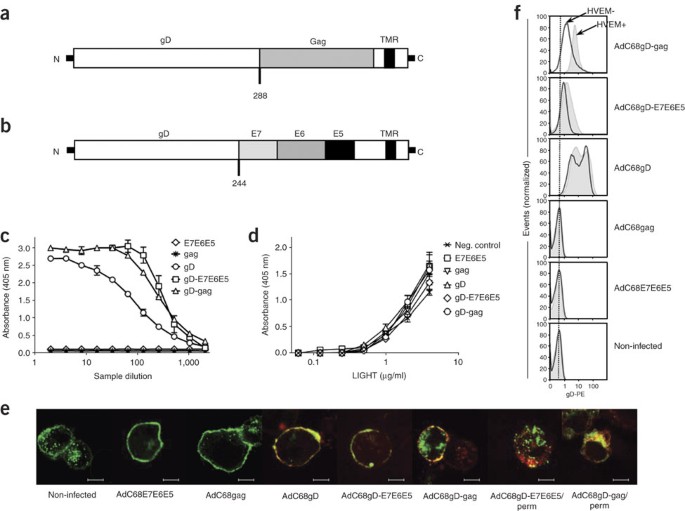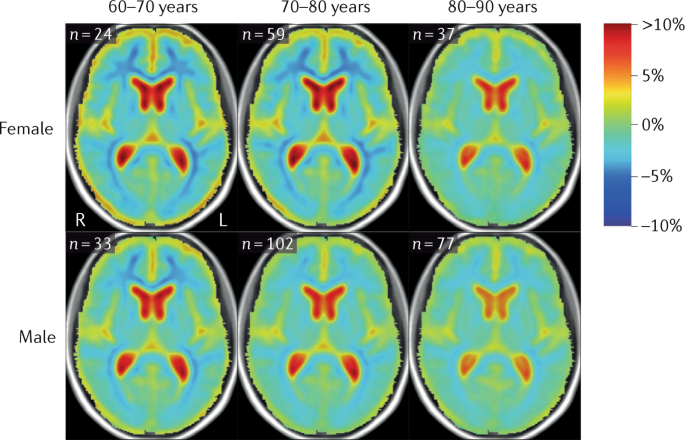
- Select a language for the TTS:
- UK English Female
- UK English Male
- US English Female
- US English Male
- Australian Female
- Australian Male
- Language selected: (auto detect) - EN
Play all audios:
ABSTRACT Interactions between the herpesvirus entry mediator (HVEM) and the B- and T-lymphocyte attenuator (BTLA) inhibit B and T cell activation. HVEM-BTLA interactions are blocked by
herpes simplex virus (HSV) glycoprotein D (gD) through binding of its N-terminal domain to the BTLA binding site of HVEM. In this study, we inserted viral antigens into the C-terminal domain
of gD and expressed these antigens with plasmid or E1-deleted (replication-defective) adenovirus vectors. Viral antigens fused to gD induced T and B cell responses to the antigen that were
far more potent than those elicited by the same antigen expressed without gD. The immunopotentiating effect required binding of the gD chimeric protein to HVEM. Overall, the studies
demonstrate that targeting of antigen to the BTLA binding site of HVEM augments the immunogenicity of vaccines. Access through your institution Buy or subscribe This is a preview of
subscription content, access via your institution ACCESS OPTIONS Access through your institution Subscribe to this journal Receive 12 print issues and online access $209.00 per year only
$17.42 per issue Learn more Buy this article * Purchase on SpringerLink * Instant access to full article PDF Buy now Prices may be subject to local taxes which are calculated during checkout
ADDITIONAL ACCESS OPTIONS: * Log in * Learn about institutional subscriptions * Read our FAQs * Contact customer support SIMILAR CONTENT BEING VIEWED BY OTHERS DELETION OF IMMUNE EVASION
GENES PROVIDES AN EFFECTIVE VACCINE DESIGN FOR TUMOR-ASSOCIATED HERPESVIRUSES Article Open access 05 November 2020 RECOMBINANT MVA-PRIME ELICITS NEUTRALIZING ANTIBODY RESPONSES BY INDUCING
ANTIGEN-SPECIFIC B CELLS IN THE GERMINAL CENTER Article Open access 25 January 2021 VIRUS-BASED VACCINE VECTORS WITH DISTINCT REPLICATION MECHANISMS DIFFERENTIALLY INFECT AND ACTIVATE
DENDRITIC CELLS Article Open access 22 November 2021 REFERENCES * Granger, S.W. & Rickert, S. LIGHT-HVEM signaling and the regulation of T cell–mediated immunity. _Cytokine Growth Factor
Rev._ 14, 289–296 (2003). Article CAS Google Scholar * Sarrias, M.R. et al. The three HveA receptor ligands, gD, LT-α and LIGHT bind to distinct sites on HveA. _Mol. Immunol._ 37,
665–673 (2000). Article CAS Google Scholar * Sedy, J.R. et al. B and T lymphocyte attenuator regulates T cell activation through interaction with herpesvirus entry mediator. _Nat.
Immunol._ 6, 90–98 (2005). Article CAS Google Scholar * Highlander, S.L. et al. Neutralizing monoclonal antibodies specific for herpes simplex virus glycoprotein D inhibit virus
penetration. _J. Virol._ 61, 3356–3364 (1987). CAS PubMed PubMed Central Google Scholar * Montgomery, R.I., Warner, M.S., Lum, B.J. & Spear, P.G. Herpes simplex virus-1 entry into
cells mediated by a novel member of the TNF/NGF receptor family. _Cell_ 87, 427–436 (1996). Article CAS Google Scholar * Connolly, S.A. et al. Structure-based mutagenesis of herpes
simplex virus glycoprotein D defines three critical regions at the gD-HveA/HVEM binding interface. _J. Virol._ 77, 8127–8140 (2003). Article CAS Google Scholar * Krummenacher, C. et al.
Structure of unliganded HSV gD reveals a mechanism for receptor-mediated activation of virus entry. _EMBO J._ 24, 4144–4153 (2005). Article CAS Google Scholar * Compaan, D.M. et al.
Attenuating lymphocyte activity: the crystal structure of the BTLA-HVEM complex. _J. Biol. Chem._ 280, 39553–39561 (2005). Article CAS Google Scholar * Cheung, T.C. et al. Evolutionarily
divergent herpesviruses modulate T cell activation by targeting the herpesvirus entry mediator cosignaling pathway. _Proc. Natl. Acad. Sci. USA_ 102, 13218–13223 (2005). Article CAS Google
Scholar * Barber, D.L. et al. Restoring function in exhausted CD8 T cells during chronic viral infection. _Nature_ 439, 682–687 (2006). Article CAS Google Scholar * Leach, D.R.,
Krummel, M.F. & Allison, J.P. Enhancement of antitumor immunity by CTLA-4 blockade. _Science_ 271, 1734–1736 (1996). Article CAS Google Scholar * Schneider, R., Campbell, M.,
Nasioulas, G., Felber, B.K. & Pavlakis, G.N. Inactivation of the human immunodeficiency virus type 1 inhibitory elements allows Rev-independent expression of Gag and Gag/protease and
particle formation. _J. Virol._ 71, 4892–4903 (1997). CAS PubMed PubMed Central Google Scholar * Fitzgerald, J.C. et al. A simian replication-defective adenoviral recombinant vaccine to
HIV-1 Gag. _J. Immunol._ 170, 1416–1422 (2003). Article CAS Google Scholar * Hensley, S.E., Giles-Davis, W., McCoy, K.C., Weninger, W. & Ertl, H.C. Dendritic cell maturation, but not
CD8+ T cell induction, is dependent on type I IFN signaling during vaccination with adenovirus vectors. _J. Immunol._ 175, 6032–6041 (2005). Article CAS Google Scholar * Lasaro, M.O.,
Diniz, M.O., Reyes-Sandoval, A., Ertl, H.C. & Ferreira, L.C. Anti-tumor DNA vaccines based on the expression of human papillomavirus-16 E6/E7 oncoproteins genetically fused with the
glycoprotein D from herpes simplex virus-1. _Microbes Infect._ 7, 1541–1550 (2005). Article CAS Google Scholar * Lin, K.Y. et al. Treatment of established tumors with a novel vaccine that
enhances major histocompatibility class II presentation of tumor antigen. _Cancer Res._ 56, 21–26 (1996). CAS PubMed Google Scholar * He, Z. et al. Viral recombinant vaccines to the E6
and E7 antigens of HPV-16. _Virology_ 270, 146–161 (2000). Article CAS Google Scholar * Kresge, K.J. Renewed promise. Annual AIDS vaccine meeting highlights recent data from clinical
trials and lessons on recruitment and retention of volunteers. _IAVI Rep._ 9, 18–20 (2005). PubMed Google Scholar * Krieg, C., Boyman, O., Fu, Y.X. & Kaye, J. B and T lymphocyte
attenuator regulates CD8+ T cell-intrinsic homeostasis and memory cell generation. _Nat. Immunol._ 8, 162–171 (2007). Article CAS Google Scholar * Hurchla, M.A. et al. B and T lymphocyte
attenuator exhibits structural and expression polymorphisms and is highly induced in anergic CD4+ T cells. _J. Immunol._ 174, 3377–3385 (2005). Article CAS Google Scholar * Han, P.,
Goularte, O.D., Rufner, K., Wilkinson, B. & Kaye, J. An inhibitory Ig superfamily protein expressed by lymphocytes and APCs is also an early marker of thymocyte positive selection. _J.
Immunol._ 172, 5931–5939 (2004). Article CAS Google Scholar * Cohen, G.H. et al. Expression of herpes simplex virus type 1 glycoprotein D deletion mutants in mammalian cells. _J. Virol._
62, 1932–1940 (1988). CAS PubMed PubMed Central Google Scholar * Friedman, H.M., Cohen, G.H., Eisenberg, R.J., Seidel, C.A. & Cines, D.B. Glycoprotein C of herpes simplex virus 1
acts as a receptor for the C3b complement component on infected cells. _Nature_ 309, 633–635 (1984). Article CAS Google Scholar * Isola, V.J. et al. Fine mapping of antigenic site II of
herpes simplex virus glycoprotein D. _J. Virol._ 63, 2325–2334 (1989). CAS PubMed PubMed Central Google Scholar * Whitbeck, J.C. et al. Glycoprotein D of herpes simplex virus (HSV) binds
directly to HVEM, a member of the tumor necrosis factor receptor superfamily and a mediator of HSV entry. _J. Virol._ 71, 6083–6093 (1997). CAS PubMed PubMed Central Google Scholar *
Bender, F.C. et al. Specific association of glycoprotein B with lipid rafts during herpes simplex virus entry. _J. Virol._ 77, 9542–9552 (2003). Article CAS Google Scholar * Carfi, A. et
al. Herpes simplex virus glycoprotein D bound to the human receptor HveA. _Mol. Cell_ 8, 169–179 (2001). Article CAS Google Scholar * Rao, Z. et al. Crystal structure of SIV matrix
antigen and implications for virus assembly. _Nature_ 378, 743–747 (1995). Article CAS Google Scholar * Monaco-Malbet, S. et al. Mutual conformational adaptations in antigen and antibody
upon complex formation between an Fab and HIV-1 capsid protein p24. _Structure_ 8, 1069–1077 (2000). Article CAS Google Scholar * Howard, B.R., Vajdos, F.F., Li, S., Sundquist, W.I. &
Hill, C.P. Structural insights into the catalytic mechanism of cyclophilin A. _Nat. Struct. Biol._ 10, 475–481 (2003). Article CAS Google Scholar Download references ACKNOWLEDGEMENTS
This work was sponsored by a US National Institutes of Health grant (AI-052271) to H.C.E.; a US National Institute of Allergy and Infectious Diseases grant (AI-18289) to J.C.W., G.H.C. and
R.J.E.; and institutional grants to the Wistar Institute including a US National Cancer Institute Cancer Core Grant (CA10815) and the Commonwealth Universal Research Enhancement Program from
the Pennsylvania Department of Health. M.O.L. was supported with a fellowship from the Cancer Research and Prevention Foundation. We thank the MHC Tetramer Core Facility (Emory University
Vaccine Center, Atlanta, Georgia) for providing the Gag-tetramer, T.C. Wu (Johns Hopkins University, Baltimore, Maryland) for providing TC-1 cells, K. High and S. Murphy (University of
Pennsylvania, Philadelphia, Pennsylvania) for human PBMC RNA samples, W. Giles-Davis for excellent technical assistance, J. Faust and M. Farabaugh for assistance with flow cytometry, J.
Hayden and F. Keeney for assistance with confocal microscopy, and C. Cole and C. Barth for preparation of the manuscript. AUTHOR INFORMATION Author notes * Scott E Hensley Present address:
Present address: Laboratory of Viral Diseases, National Institute of Allergy and Infectious Diseases, National Institutes of Health, Bethesda, Maryland 20892, USA., AUTHORS AND AFFILIATIONS
* The Wistar Institute, 3601 Spruce Street, Philadelphia, 19104, Pennsylvania, USA Marcio O Lasaro, Nia Tatsis, Scott E Hensley, Shih-Wen Lin, John J Rux, E John Wherry & Hildegund C
Ertl * School of Veterinary Medicine, University of Pennsylvania, Philadelphia, 19104, Pennsylvania, USA J Charles Whitbeck & Roselyn J Eisenberg * School of Dental Medicine, University
of Pennsylvania, Philadelphia, 19104, Pennsylvania, USA J Charles Whitbeck, Gary H Cohen & Roselyn J Eisenberg * School of Medicine, University of Pennsylvania, Philadelphia, 19104,
Pennsylvania, USA Shih-Wen Lin Authors * Marcio O Lasaro View author publications You can also search for this author inPubMed Google Scholar * Nia Tatsis View author publications You can
also search for this author inPubMed Google Scholar * Scott E Hensley View author publications You can also search for this author inPubMed Google Scholar * J Charles Whitbeck View author
publications You can also search for this author inPubMed Google Scholar * Shih-Wen Lin View author publications You can also search for this author inPubMed Google Scholar * John J Rux View
author publications You can also search for this author inPubMed Google Scholar * E John Wherry View author publications You can also search for this author inPubMed Google Scholar * Gary H
Cohen View author publications You can also search for this author inPubMed Google Scholar * Roselyn J Eisenberg View author publications You can also search for this author inPubMed Google
Scholar * Hildegund C Ertl View author publications You can also search for this author inPubMed Google Scholar CONTRIBUTIONS M.O.L. planned and performed most of the experiments and wrote
the manuscript; N.T. and S.E.H. planned some experiments and contributed to writing of the manuscript; J.C.W. and S.-W.L. planned and performed some of the experiments; J.J.R. performed the
molecular modeling; E.J.W. provided technical advice; G.H.C. and R.J.E. provided advice; and H.C.E. supervised all experimental procedures and helped to write the manuscript. CORRESPONDING
AUTHOR Correspondence to Hildegund C Ertl. ETHICS DECLARATIONS COMPETING INTERESTS H.C.E. and M.O.L. have applied for international patent PCT/US2007/018939, “Constructs for Enhancing Immune
Responses.” SUPPLEMENTARY INFORMATION SUPPLEMENTARY TEXT AND FIGURES Supplementary Figs. 1–5 and Supplementary Tables 1 & 2 (PDF 1048 kb) RIGHTS AND PERMISSIONS Reprints and permissions
ABOUT THIS ARTICLE CITE THIS ARTICLE Lasaro, M., Tatsis, N., Hensley, S. _et al._ Targeting of antigen to the herpesvirus entry mediator augments primary adaptive immune responses. _Nat
Med_ 14, 205–212 (2008). https://doi.org/10.1038/nm1704 Download citation * Received: 14 September 2007 * Accepted: 05 December 2007 * Published: 13 January 2008 * Issue Date: February 2008
* DOI: https://doi.org/10.1038/nm1704 SHARE THIS ARTICLE Anyone you share the following link with will be able to read this content: Get shareable link Sorry, a shareable link is not
currently available for this article. Copy to clipboard Provided by the Springer Nature SharedIt content-sharing initiative







